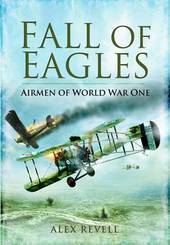
|
Fall of Eagles: the Evolution of Air Warfare in World War One
Hardback
Main Details
| Title |
Fall of Eagles: the Evolution of Air Warfare in World War One
|
| Authors and Contributors |
By (author) Alex Revell
|
| Physical Properties |
| Format:Hardback | | Pages:256 | | Dimensions(mm): Height 234,Width 156 |
|
| Category/Genre | First world war |
|---|
| ISBN/Barcode |
9781848845275
|
| Classifications | Dewey:940.440922 |
|---|
| Audience | |
|---|
| Illustrations |
36 Mono in plate section
|
|
Publishing Details |
| Publisher |
Pen & Sword Books Ltd
|
| Imprint |
Pen & Sword Aviation
|
| Publication Date |
16 June 2011 |
| Publication Country |
United Kingdom
|
Description
The Great War of 1914-1918 saw the rapid development of the aeroplane as a weapon of war. Initially its role was seen as that of reconnaissance, an extension of the cavalry, but as the war stagnated into static trench warfare, with each side facing each other across No-Man's-Land, the use of artillery, both in shelling enemy positions and counter-shelling his artillery, also became of prime importance. With the early development of radio communication between ground and air, aeroplanes also undertook the task of "spotting" for the artillery, and it soon became apparent that these aeroplanes - both the reconnaissance machines and those working for the artillery - could not be allowed to work unmolested, and fast fighter aeroplanes - both single and two seat - began to make their appearance over the Western Front. Technical development was rapid. The mostly unarmed reconnaissance aeroplanes, and the early fighters of 1915 and 1916, armed with a single machine gun, had given way to fighters carrying two guns, flying at altitudes of over 16,000 feet and at treble the speed of the predecessors of 1914. With these developments a new type of soldier had evolved: the fighter pilot. Capable of fighting in the air, in three dimensions and at great speed, individual pilots began to emerge whose singular talents and temperament brought them to the forefront of their respective air forces. They became the "aces", pilots who had brought down five or more of the enemy. Despite their expertise, few of these "aces" survived the war. The last combatants of some are known and well documented, others are obscure. Some of the pilots in these pages are well known, others less so, but all shared the common experience of fighting in the air during the war of 1914-1918: the conflict which saw the aeroplane evolve from a relatively fragile, unarmed reconnaissance machine, to a deadly weapon that changed the face of the war forever. AUTHOR: Revell has written many aviation books and is respected amongst the literary community. SELLING POINTS: . First-hand accounts of the early days of fighting. . The development of air fighting techniques when in their infancy. . Includes legendary aces and unsung heroes. ILLUSTRATIONS: 36 Mono in plate section *
Author Biography
Alex Revell is an author and historian.
Reviews"...an excellent book that tells the stories of many great airmen of the First World War...includes bibliography as well as 32 pages of outstanding photos that add greatly to the interesting stories."-- "Aerodrome"
|